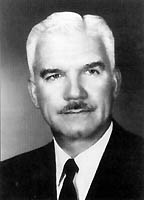
October 24, 2013
AASHTO Presidential Profile: Bertram D. Tallamy, New York

The American Association of State Highway Officials chose Bertram Dalley Tallamy, who was New York State Superintendent of Public Works and Chairman of the New York State Thruway Authority, as the association’s 39th president from 1951-1952, a time filled with unprecedented changes and challenges for highways development nationwide.
The United States was facing a dramatic upsurge in population, motor vehicles ownership, and traffic, and states had to deal with the consequent need to build and maintain highways that could accommodate those ever-increasing numbers. With World War II still a recent memory and the Cold War taking deeper root each year, there was also a strong demand for highways that could serve as a lifeline for national defense.
Tallamy was born on Dec. 1, 1901, in Plainfield, N.J. Tallamy received a degree in civil engineering from the Rensselaer Polytechnic Institute in 1925, and subsequently acquired substantial engineering experience in waterworks, dams, sewage treatment plants, roads, and bridges.
In 1945, Tallamy was named deputy superintendent of the New York State Department of Public Works. He became that agency’s chief engineer two years later. In 1948, he was appointed superintendent. One of Tallamy’s key achievements involved supervising and promoting the construction of what is now officially called the Thomas E. Dewey Thruway. In 1950, Tallamy took on yet another leadership role as chairman of the newly created New York State Thruway Authority.
Tallamy likewise assumed leadership responsibilities on behalf of AASHO. He was elected a member of the association’s Executive Committee in 1948, and the following year became first vice president. Tallamy was elected AASHO president at the association’s annual meeting in in Omaha, Neb., in October 1951.
As AASHO president, Tallamy sought to promote the growing importance of the nation’s highways and the need to sustain and adequately fund that transportation network in a climate characterized by international turmoil and domestic shortages in manpower and materials. He cited as accomplishments both stronger public support for improved highways and the passage of the Federal-Aid Highway Act of 1952 (at the time the largest federal-aid measure of its kind).
Tallamy remained New York’s Superintendent of Public Works until December 1954. Just a little more than two years later, he was sworn in by U.S. Secretary of Commerce Sinclair Weeks as the first Federal Highway Administrator to be confirmed by the Senate. Tallamy, who served in that position until 1961, directed what was the initial construction of the 41,000 miles constituting the then recently authorized Interstate Highway System.
After leaving the Federal Highway Administration, Tallamy remained in the nation’s capital as a consulting engineer and stayed active in that capacity until 1970. He died on Sept.14, 1989, in Washington, D.C., at the age of 87.












